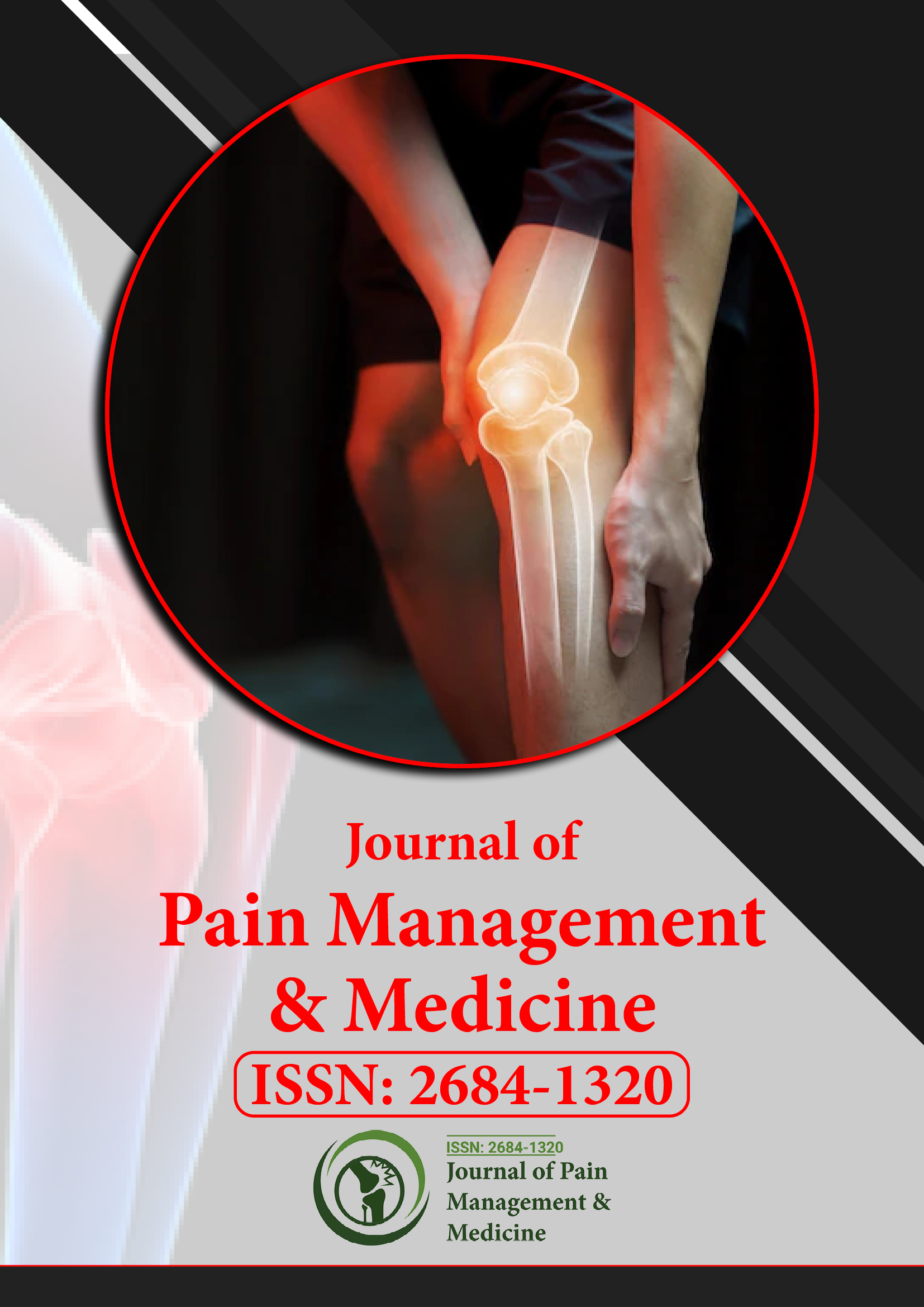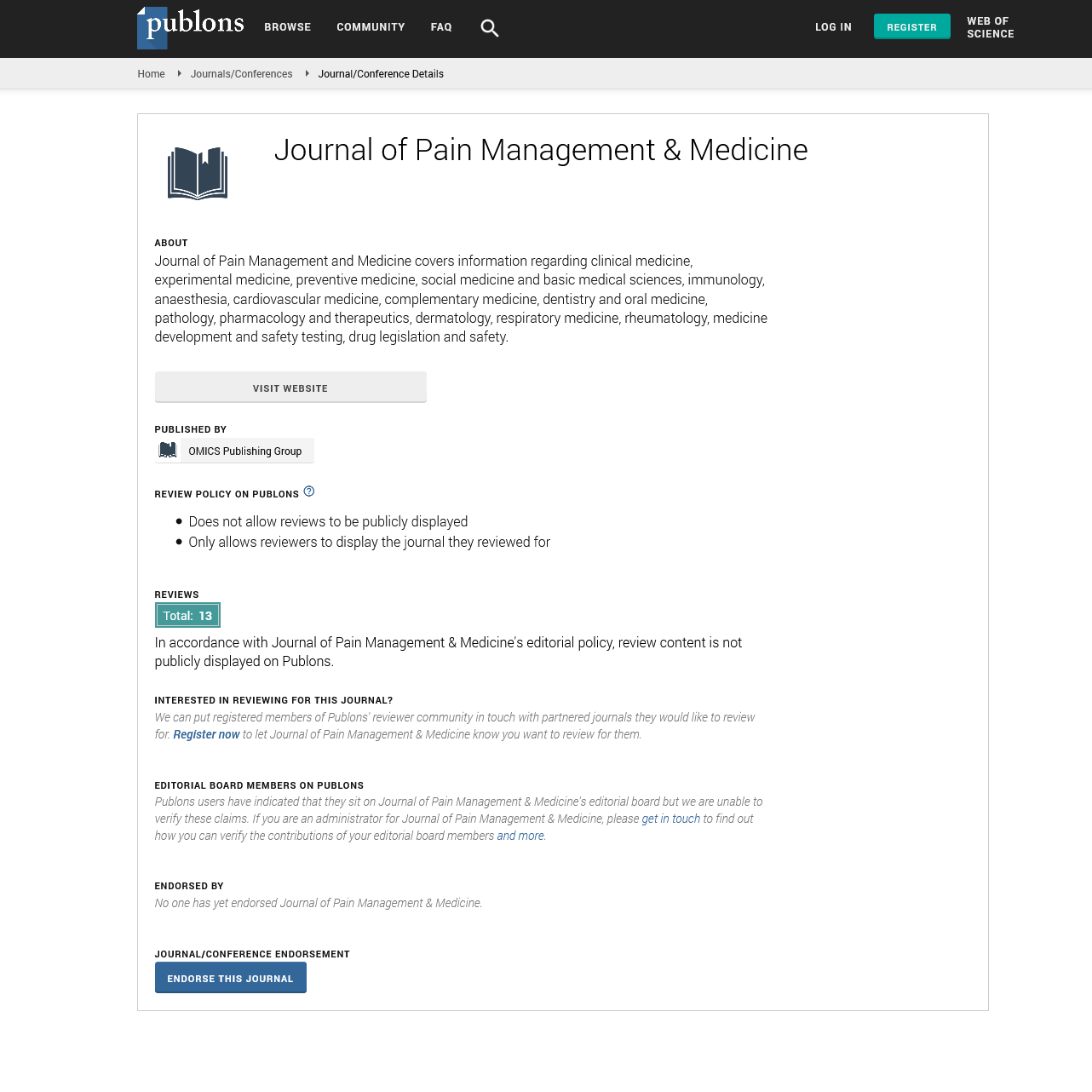Indexed In
- RefSeek
- Hamdard University
- EBSCO A-Z
- Publons
- Euro Pub
- Google Scholar
- Quality Open Access Market
Useful Links
Share This Page
Journal Flyer

Open Access Journals
- Agri and Aquaculture
- Biochemistry
- Bioinformatics & Systems Biology
- Business & Management
- Chemistry
- Clinical Sciences
- Engineering
- Food & Nutrition
- General Science
- Genetics & Molecular Biology
- Immunology & Microbiology
- Medical Sciences
- Neuroscience & Psychology
- Nursing & Health Care
- Pharmaceutical Sciences
Short Communication - (2024) Volume 10, Issue 2
Mechanism of Chronic Pain and its Treatment Methods
Melanie Juan*Received: 01-Mar-2024, Manuscript No. JPMME-24-25639; Editor assigned: 04-Mar-2024, Pre QC No. JPMME-24-25639 (PQ); Reviewed: 18-Mar-2024, QC No. JPMME-24-25639; Revised: 26-Mar-2024, Manuscript No. JPMME-24-25639 (R); Published: 04-Apr-2024, DOI: 10.35248/2684-1320.24.10.256
Description
Chronic pain, a complex and common condition that affect millions of individuals around the world, it is utilizing an immense impact on physical, emotional, and social well-being. In comparison to acute pain, which acts as a potential signal of tissue damage or injury and usually decreases with rehabilitation, chronic pain endures long than anticipated, frequently for months or even years. From musculoskeletal disorders to neuropathic conditions, from autoimmune diseases to psychological factors, chronic pain can arise from a several fundamental causes. Presenting unique challenges for diagnosis, treatment, and management. Moreover, chronic pain is frequently accompanied by multiple illnesses such as anxiety, depression, and fatigue, further exacerbating the burden on affected individuals. The multidimensional nature of chronic pain demands a comprehensive method to care not only the physical symptoms but also the psychological, social, and environmental factors that contribute to its persistence [1-3].
Understanding the underlying mechanisms of chronic pain is essential for effective management and treatment. While acute pain serves a protective function, alerting the body to potential harm and stimulates rehabilitation, chronic pain involves complex interactions between the nervous system, immune system, and psychological factors. Peripheral sensitization, central sensitization, and neuroplastic changes in the brain contribute to the amplification and persistence of pain signals, leading to a state of hyper excitability and altered pain perception. Moreover, psychosocial factors such as stress, trauma, and maladaptive Survival methods can further exacerbate pain intensity and disability produces an endless cycle of pain.
Diagnosing chronic pain requires an evaluation encompassing medical history, physical examination, diagnostic tests, and psychosocial assessment. Healthcare providers utilize validated pain assessment tools such as the Visual Analog Scale (VAS), the Brief Pain Inventory (BPI), and the McGill Pain Questionnaire to quantify pain intensity, location, and impact on daily functioning. Additionally, imaging studies such as X-rays, Magnetic Resonance Imaging (MRI) scans, and nerve conduction studies may be employed to identify structural abnormalities or nerve dysfunction contributing to pain symptoms. However, it is important to recognize that chronic pain is frequently complex and multifaceted condition, and a comprehensive understanding of the patient's individual experience is essential for guiding treatment decisions [4].
Treatment approaches for chronic pain are varied and multifaceted, tailored to the unique needs and preferences of each individual. A multidisciplinary technique to care, involving collaboration between healthcare providers from diverse specialties, provides the best chance for comprehensive pain management and improved outcomes. Pharmacological interventions such as analgesics, anti-inflammatories, antidepressants, and anticonvulsants may be prescribed to alleviate pain, modulate neurotransmitter activity, and improve mood and sleep disturbances. However, it's important to use caution with opioid medications due to the risk of dependence, tolerance, and adverse effects [5,6].
Additionally, a non-pharmacological intervention plays an important role in chronic pain management, addressing both the physical and psychological dimensions of the condition. Physical therapy modalities such as exercise, manual therapy, and therapeutic modalities (e.g., heat, cold, and ultrasound) can helps to improve strength, flexibility, and functional mobility, reducing pain intensity and disability. Cognitive-Behavioral Therapy (CBT), Mindfulness-Based Stress Reduction (MBSR), and Acceptance and Commitment Therapy (ACT) provide effective techniques for managing with pain, stress, and increasing psychological well-being [7-9].
Furthermore, interventional procedures such as nerve blocks, epidural injections, and radiofrequency ablation may be considered for targeted pain relief in some cases where conservative treatments have been ineffective. These procedures aim to disrupt pain signals and modulate nerve activity, providing temporary or long-term pain relief for select patients. Additionally, complementary and alternative therapies such as acupuncture, massage therapy, and chiropractic care may provide additional options for symptom management and general healing [10].
References
- McQuay H. Opioids in pain management. Lancet. 1999;353(9171):2229-2232.
- Ferrell BA. Pain management. Clin Geriatr Med. 2000;16(4):853-873.
- Morad A, Farrokh S. Essentials of anesthesia for neurotrauma. 2018;pp: 447-460.
- Gatchel RJ. Clinical essentials of pain management. American Psychological Association. 2005.
- Gerner P. Postthoracotomy pain management problems. Anesthesiol Clin. 2008;26(2):355-367.
- Prabhakar H, Mahajan C, Kapoor I. Essentials of Anesthesia for Neurotrauma. CRC Press. 2018.
- Ferrell BA. Pain management in elderly people. J Am Geriatr Soc. 1991.
- Loeser JD, Melzack R. Pain: An overview. Lancet. 1999;353(9164):1607-1609.
[Crossref] [Google Scholar] [PubMed]
- Breivik H, Borchgrevink PC, Allen SM, Rosseland LA, Romundstad L, Breivik Hals EK, et al. Assessment of pain. Br J Anaesth. 2008;101(1):17-24.
- Huskisson EC. Measurement of pain. Lancet. 1974;304(7889):1127-1131.
Citation: Juan M (2024) Mechanism of Chronic Pain and its Treatment Methods. J Pain Manage Med.10:256.
Copyright: © 2024 Juan M. This is an open access article distributed under the terms of the Creative Commons Attribution License, which permits unrestricted use, distribution, and reproduction in any medium, provided the original author and source are credited.

